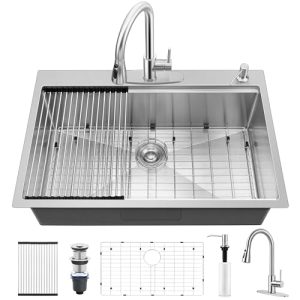Are you having trouble with your Kitchen Aid dishwasher not working properly? Sometimes, a simple reset can fix the problem quickly and save you time and money.
In this guide, you’ll learn exactly how to reset your Kitchen Aid dishwasher step by step. Whether your dishwasher won’t start, is stuck mid-cycle, or shows error codes, this easy reset process can help you get it back to running smoothly.
Keep reading to discover the simple tricks that will have your dishwasher working like new again.
Signs You Need A Reset
Knowing when to reset your Kitchen Aid dishwasher can save you time and frustration. A reset can clear glitches and restore smooth operation without needing a costly service call. Watch for clear signs that your dishwasher is struggling to function properly—these signals often mean a reset is necessary.
Common Error Codes
Your dishwasher may display error codes like “E1,” “E2,” or “E4” on the control panel. These codes indicate issues such as water supply problems or drainage errors. Don’t ignore these warnings; they often mean the machine needs a reset to clear the fault and start fresh.
Unresponsive Controls
Have you ever pressed the buttons on your dishwasher only to get no response? This unresponsiveness can happen when the control board freezes or glitches. A reset can reboot the system and bring your controls back to life, saving you the hassle of replacing parts prematurely.
Cycle Interruptions
If your dishwasher stops mid-cycle or won’t complete a wash, it’s a red flag. Power hiccups or software glitches can cause these interruptions. Resetting the dishwasher often resolves this by restarting the cycle sequence, so you don’t have to start over manually.
Preparing For The Reset
Preparing for the reset is an important step to ensure your Kitchen Aid dishwasher works properly again. Taking time to get ready helps avoid mistakes and keeps you safe. Follow these simple steps before starting the reset process.
Safety Precautions
Always unplug the dishwasher from the power source before starting. This prevents electric shocks or damage. Avoid touching any wet surfaces or metal parts inside the dishwasher. Keep children and pets away during the reset process. Use dry hands and a dry cloth to handle controls.
Gathering Necessary Tools
Most resets require no special tools, but having some items ready helps. Prepare a soft cloth to clean buttons and the control panel. Keep a flashlight nearby to see inside dark areas. Have your dishwasher manual handy for reference. If needed, a small screwdriver can open the control panel cover.
Locating The Dishwasher Control Panel
The control panel is usually on the top edge of the dishwasher door. Open the door fully to see the buttons and display screen. Some models have the panel hidden under the door lip. Check your manual if you cannot find it. Make sure the panel is clean and dry before starting the reset.
Reset Methods For Kitchen Aid Dishwashers
Resetting your Kitchen Aid dishwasher can solve many common issues, from unresponsive controls to cycle interruptions. Knowing the right reset method saves you time and avoids unnecessary service calls. Let’s look at simple ways to reset your dishwasher and get it running smoothly again.
Basic Control Panel Reset
A basic control panel reset is often enough to clear minor glitches. Start by pressing the “Start/Resume” button to pause any active cycle. Then hold down the “Heated Dry” and “Normal Wash” buttons simultaneously for about 3 seconds until the control panel lights blink or go off.
This resets the control board without unplugging the unit. It’s a quick fix if your dishwasher won’t start or responds slowly. Have you tried this yet before calling for service?
Power Cycle Reset
Power cycling your dishwasher is like giving it a quick reboot. Turn off the dishwasher and unplug it from the wall outlet. Wait for 5 minutes to let any residual power drain from the electronics.
Plug the dishwasher back in and turn it on. This method clears temporary software errors and resets the system. If your dishwasher freezes mid-cycle, this can be a handy trick to try first.
Using The Cancel Or Reset Button
Many Kitchen Aid models include a dedicated “Cancel” or “Reset” button for a straightforward reset. Press and hold this button for 3 to 5 seconds until you hear a beep or the dishwasher lights flash.
This cancels the current cycle and resets the dishwasher to standby mode. It’s useful if you want to stop a cycle quickly and start fresh. Does your model have this button? Check your manual to locate it.
Step-by-step Reset Process
Resetting your KitchenAid dishwasher can fix common issues. Follow these steps carefully for a successful reset. Each step ensures your dishwasher runs smoothly and efficiently. Read through the instructions before starting the reset process.
Step 1: Turn Off The Dishwasher
Begin by switching off your dishwasher. Ensure it is not running any cycles. Check the control panel for any active lights. Press the “Off” button to stop current operations.
Step 2: Disconnect Power
Disconnect the dishwasher from the power source. This can be done by unplugging it from the wall. If your dishwasher is hardwired, turn off the circuit breaker. Ensure no power is flowing to the appliance.
Step 3: Wait And Reconnect
Wait for at least 5 minutes. This allows the internal systems to reset. Reconnect the dishwasher to the power source after waiting. Ensure the plug is secure, or the circuit breaker is turned on.
Step 4: Initiate Reset Sequence
Initiate the reset sequence using the control panel. Press the “Start” or “Reset” button. Hold for a few seconds until lights blink. This indicates the reset process has started. Check the manual for specific button instructions if needed.
Troubleshooting Post-reset Issues
Resetting a KitchenAid dishwasher often fixes common problems quickly. Sometimes, issues remain after the reset. Troubleshooting post-reset problems can help identify and solve these lingering faults. Careful checks can restore your dishwasher’s performance without extra costs.
When Reset Fails
Sometimes, the dishwasher does not respond after a reset. The control panel may stay unresponsive or show error codes. This suggests deeper electronic or software issues. Power cycling the unit by unplugging it for a few minutes can help. If the problem persists, the control board might need professional inspection or replacement.
Checking Water Supply And Drainage
Water supply issues often cause dishwasher malfunctions after a reset. Check if the water valve is open and the hose is not kinked. Inspect the inlet filter for clogs that block water flow. Drainage problems can cause water to stay inside. Clear the drain hose and remove debris from the drain pump. Proper water flow is essential for dishwasher cycles to complete.
Inspecting Door Latch And Sensors
The dishwasher will not start if the door latch is faulty. Ensure the door closes firmly and the latch clicks into place. Dirty or damaged sensors can send wrong signals to the control panel. Clean the sensors gently with a soft cloth. Replace any broken or worn parts to restore proper operation.
Preventing Future Reset Needs
Preventing future reset needs keeps your Kitchen Aid dishwasher running smoothly. Small efforts protect its parts and improve performance. Avoiding frequent resets saves time and frustration. Follow simple habits to maintain your dishwasher well.
Regular Maintenance Tips
Clean the filter monthly to stop clogs. Wipe the door seals to remove dirt and grime. Check spray arms for blockages and clear them gently. Run a cleaning cycle using dishwasher cleaner every few months. Keep the drain free from food particles. Regular care prevents errors that cause resets.
Proper Loading Techniques
Place dishes so water reaches all surfaces. Avoid overloading; give space between items. Position large items at the sides and back. Make sure nothing blocks the spray arms. Load plastic items on the top rack only. Correct loading reduces strain and helps the dishwasher work well.
Using Recommended Detergents
Use detergents made for dishwashers only. Avoid using regular dish soap; it creates too many suds. Check your manual for detergent type and amount. Using the right detergent stops buildup and sensor errors. This keeps your dishwasher clean and prevents resets.
Frequently Asked Questions
How Do I Reset My Kitchen Aid Dishwasher?
To reset, press the “Heated Dry” and “Normal” buttons simultaneously. Hold for 3 seconds. The dishwasher will reset and restart its cycle.
Why Does My Kitchen Aid Dishwasher Need A Reset?
A reset fixes minor glitches, error codes, or unresponsive controls. It restores normal function without professional help, saving time and cost.
How Long Does A Kitchen Aid Dishwasher Reset Take?
The reset process takes about 3 seconds to initiate. After that, the dishwasher may take a few minutes to restart and resume normal operation.
Can Resetting Fix Dishwasher Error Codes?
Yes, resetting can clear certain error codes caused by temporary issues. Persistent errors may need further diagnosis or professional repair.
Conclusion
Resetting your Kitchen Aid dishwasher is simple and quick. Follow the steps carefully for best results. This process helps fix common errors and improves performance. Regular resets can keep your dishwasher running smoothly. Take your time and be patient during the reset.
Now, your dishwasher should work like new again. Keep this guide handy for future reference. Enjoy clean dishes with less hassle.

Sophie Hartwell is the founder of KitchenQuik.com, where she shares kitchen tips, smart cooking hacks, and the best product picks to make everyday cooking easier and more enjoyable.




